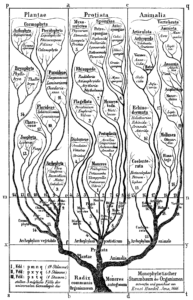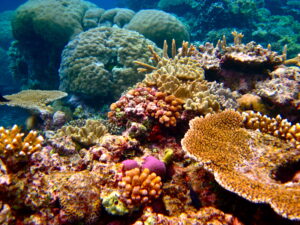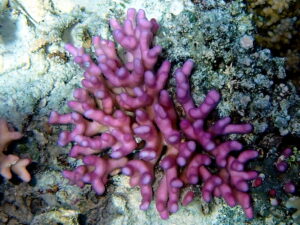Quek, Z. R., Jain, S. S., Richards, Z. T., Arrigoni, R., Benzoni, F., Hoeksema, B. W., Carvajal, J. I., Wilson, N. G., Baird, A. H., Kitahara, M. V., Seiblitz, I. G. L., Vaga, C. F., & Huang, D. (2023). A hybrid-capture approach to reconstruct the phylogeny of Scleractinia (Cnidaria: Hexacorallia). Molecular Phylogenetics and Evolution, 107867. https://doi.org/10.1016/j.ympev.2023.107867

One of the major goals of biology is to learn how organisms are related to one another. Understanding relationships between species is important for everything from ecology to medicine. For example, we know that humans and mice are pretty closely related, so studying cancer in mice can help us learn about human cancers. The study of evolutionary relationships is called “phylogenetics,” and we often depict these relationships with phylogenetic trees. A
Reef-building corals include hundreds of species with a huge diversity of shapes and sizes. These animals create and maintain coral reef ecosystems, but are severely threatened by climate change. Despite their importance, there’s still a lot we don’t know about the coral family tree! Sometimes, we can identify species simply by appearance. However, many species of corals look very similar to one another, and different members of the same species can also look quite different. We need to use genetic data (DNA) in order to build a coral phylogeny—but many corals haven’t yet had their DNA sequenced, partly because sampling animals in the ocean is more difficult than on land.
The corals that most people are familiar with are called stony corals or hard corals, and this group includes the reef-building animals that form large, complex skeletons. In a recent study, biologists used new genetic data to resolve the major relationships among stony corals. This is the largest genetic study of stony corals so far.
Modern phylogenetics meets stony corals
Historically, scientists built phylogenies based on a small number of DNA “markers”—a single gene or short part of the genome. The basic idea is that close relatives have similar DNA, because DNA accumulates differences over time due to new mutations. We can use mathematical models of evolution to reconstruct the most likely history that produced the DNA sequences, and represent this history with a tree. However, single markers can be too short and might not contain enough information to build an accurate phylogeny. Some species are difficult to place in a tree, despite our best efforts, and this includes various groups of corals.

Nowadays, we can sequence most of an animal’s genome, drastically expanding the amount of information available for phylogenetics. Modern genetic studies often use tens or hundreds of thousands of DNA bases (a base is the basic “unit” of DNA), whereas an old-fashioned marker gene might only be a few hundred bases long. Scientists hope that, by sequencing more and more genetic data, we can figure out some of these tricky relationships.
In this study, scientists assembled a huge dataset, containing hundreds of stony coral species, and used it to build the most comprehensive coral family tree to date. Some parts of the tree that had been previously studied were confirmed, and we now have more confidence in those relationships. New species have been added to the tree, and we’ve learned where to place some species whose relationships were previously unknown. Although this is an important resource, the story isn’t over! There are still some species and parts of the tree that we cannot confidently place.
More data, more problems?

To conserve biodiversity, we first need to understand what diversity already exists. When we look at a reef, what evolutionary lineages are present, and how are species related to one another across different reefs? How do different species with different evolutionary histories respond to climate change? Studies like this one help us answer these questions and make informed decisions about which reefs and species to prioritize for conservation.
Although more data might seem like a good thing, it also raises new challenges. We actually have so much genetic data these days that our computers can’t analyze all of it. Large studies need expensive super-computers, and it can still take weeks to build a single tree. Unfortunately, even though we can use more and more complex models and bigger and bigger datasets, some parts of the tree of life are still very difficult to untangle. Resolving these questions will be a huge task requiring increased sampling of animals in the wild, technological advancements in DNA sequencing, and computational advances to make the best use of these big datasets.
Cover image source: Albert Kok, via Wikimedia Commons

I am a PhD student at MIT and the Woods Hole Oceanographic Institution, where I study the evolution and physiology of marine invertebrates. I usually work with zooplankton and sea anemones, and I am especially interested in circadian rhythms of these animals. Outside work, I love to play trumpet, listen to music, and watch hockey.

